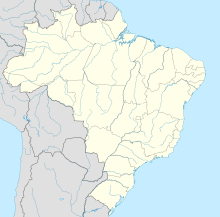Viação Aérea São Paulo S/A, better known as VASP, was an airline with its head office in the VASP Building on the grounds of São Paulo–Congonhas Airport in São Paulo, Brazil. It had main bases at São Paulo's two major airports, São Paulo–Congonhas Airport (CGH) and São Paulo/Guarulhos International Airport (GRU).
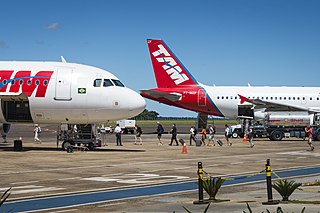
Foz do Iguaçu/Cataratas International Airport, is the airport serving Foz do Iguaçu, Brazil. It is named after the Iguazu Falls and provides air-connections to the falls located at Iguaçu National Park.

São Paulo/Congonhas–Deputado Freitas Nobre Airport[kõˈɡõɲɐs] is one of the four commercial airports serving São Paulo, Brazil. The airport is named after the neighborhood where it is located, called Vila Congonhas, property of the descendants of Lucas Antônio Monteiro de Barros (1767–1851), Viscount of Congonhas do Campo, first president of the Province of São Paulo after the independence of Brazil in 1822, during the Empire. In turn, the Viscount's domain was named after the plural of a shrub known in Brazil as congonha-do-campo. Since June 19, 2017, it is officially named after Deputy Freitas Nobre. The name Congonhas, however, remains mostly used. It is owned by the City of São Paulo.
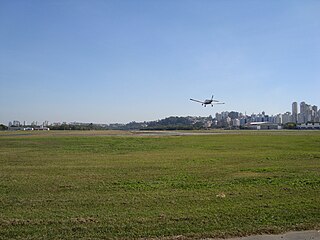
Campo de Marte Airport is the first airport built in São Paulo, Brazil, opened in 1929. It is named after Champ de Mars, in Paris, which in turn got its name from Campus Martius, in Rome.
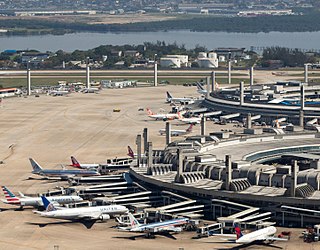
Rio de Janeiro/Galeão – Antonio Carlos Jobim International Airport, popularly known by its original name Galeão International Airport, is the main airport serving Rio de Janeiro, Brazil. In 2019, it was the country's fourth-busiest airport by passenger traffic. It is named after the neighborhood of Galeão. Praia do Galeão is located in front of the original passenger terminal and where the galleon Padre Eterno was built in 1663. Since 5 January 1999 it is also named after Brazilian musician Antonio Carlos Jobim. Galeão Airport is explicitly mentioned in his composition Samba do Avião. It is the largest airport site in terms of area in Brazil.

Afonso Pena International Airport is the main airport serving Curitiba, Brazil, located in the adjoining municipality of São José dos Pinhais. It is named after Afonso Pena (1847–1909), the 6th President of Brazil.

Santos Dumont Airport is the second major airport serving Rio de Janeiro, Brazil. It is named after the Brazilian aviation pioneer Alberto Santos Dumont (1873–1932). It is operated by Infraero.

Manaus International Airport – Eduardo Gomes is the airport serving Manaus, Brazil. It is named after Brazilian politician and military figure Air Marshal Eduardo Gomes (1896–1981).

Pampulha–Carlos Drummond de Andrade Airport is an airport serving Belo Horizonte, Brazil, located in the neighborhood of Pampulha. Since December 16, 2004 the airport is also named after the Minas Gerais-born poet Carlos Drummond de Andrade (1902–1987).

Fortaleza-Pinto Martins International Airport is the international airport serving Fortaleza, Brazil. It is named after Euclides Pinto Martins (1892–1924) a Ceará-born aviator, who in 1922 was one of the pioneers of the air-link between New York City and Rio de Janeiro.

Santa Genoveva/Goiânia International Airport is the airport serving Goiânia, Brazil.
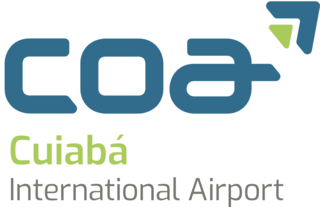
Marechal Rondon International Airport is the airport serving Cuiabá, Brazil, located in the adjoining municipality of Várzea Grande. It is named after Marshall Cândido Mariano da Silva Rondon (1865–1958), a Brazilian explorer.

Cruzeiro do Sul International Airport is the airport serving Cruzeiro do Sul, Brazil. It is the westernmost Brazilian airport served by scheduled flights.
Ponta Pelada Airport was the main airport of Manaus, Brazil until 1976. Between 1970 and 1976, the facilities were shared with Manaus Air Force Base of the Brazilian Air Force. On March 31, 1976, all civilian operations were transferred to the newer Eduardo Gomes International Airport. During this transition, Ponta Pelada Airport was renamed Manaus Air Force Base handling military operations exclusively under the control of the Brazilian Air Force.
VARIG was the first airline founded in Brazil, in 1927. From 1965 until 1990, it was Brazil's leading airline, and virtually its only international one. In 2005, Varig went into judicial restructuring, and in 2006 it was split into two companies – Flex Linhas Aéreas, informally known as "old" Varig, heir to the original airline – now defunct, and "new" Varig, a new company, fully integrated into Gol Airlines.

Comandante João Ribeiro de Barros Airport is an airport serving Bauru, Brazil.

Londrina – Gov. José Richa Airport is the airport serving Londrina, Brazil. It is named after José Richa (1934–2003), former Mayor of Londrina and Governor of Paraná.

Brasília–Presidente Juscelino Kubitschek International Airport is the only international airport serving Brasília. The airport was named after Juscelino Kubitschek (1902–1976), the 21st President of Brazil. It is located in the administrative region of Lago Sul, in the Federal District, and is operated by Inframerica. Some of its facilities are shared with the Brasília Air Force Base of the Brazilian Air Force.

Presidente João Figueiredo Airport is the airport serving Sinop, Brazil. It is named after João Baptista de Oliveira Figueiredo, the 30th President of Brazil.
Manguinhos Airport was an airport that existed in the neighborhood of Manguinhos, near Oswaldo Cruz Foundation in Rio de Janeiro from 1936 to 1972.

